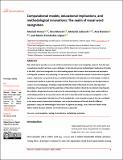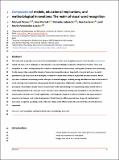Por favor, use este identificador para citar o enlazar a este item:
http://hdl.handle.net/10261/286903COMPARTIR / EXPORTAR:
 SHARE SHARE
 CORE
BASE CORE
BASE
|
|
| Visualizar otros formatos: MARC | Dublin Core | RDF | ORE | MODS | METS | DIDL | DATACITE | |

| Título: | Computational models, educational implications, and methodological innovations: The realm of visual word recognition |
Autor: | Perea, Manuel; Marcet, Ana; Labusch, Melanie; Baciero, Ana; Fernández-López, María | Palabras clave: | Word recognition Reading Lexical decision Methodology Education |
Fecha de publicación: | 2023 | Editor: | DIGITAL.CSIC | Citación: | Psicologica 44(2): e15259 (2023) | Resumen: | This article aims to provide an overview of the current status of visual word recognition research, from the main models and their current challenges, to the educational and methodological implications of studies in this field. Visual word recognition is a critical reading process that connects visual sensation and perception with linguistic (sentence, text) processing. For this reason, it has captured the interest of researchers in cognitive science. Importantly, it is particularly easy to model quantitatively and researchers have developed a number of computational models to explain the processes involved. Recent years have witnessed an increasing number of corpora in several languages, including average identification times of thousands of words, allowing virtual simulations of experiments to test the predictions of theoretical models without the recruitment of participants. Nevertheless, despite the advances achieved in the understanding of word processing, models still have outstanding questions to be answered, such as the role of visual information during word recognition, or how diacritics are represented at the letter level. On the applied side, word recognition research has also contributed to the improvement of educational techniques, such as the development of friendly fonts for different populations, along with methodological innovations in cognitive psychology, such as the use of linear-mixed effects models, Bayesian methods and multi-laboratory approaches. | Versión del editor: | https://doi.org/10.20350/digitalCSIC/15259 | URI: | http://hdl.handle.net/10261/286903 | DOI: | 10.20350/digitalCSIC/15259 | Reputación del trabajo revisado: | 56 |
| Revisiones por pares | 70Ver revisión de Lázaro, Miguel 70Ver revisión de Pérez-Sánchez, Miguel Á |
| Aparece en las colecciones: | Psicológica Journal |
Ficheros en este ítem:
| Fichero | Descripción | Tamaño | Formato | |
|---|---|---|---|---|
| Perea_2023_FINAL.pdf | Perea_2023_FINAL | 565,28 kB | Adobe PDF |  Visualizar/Abrir |
| Perea_2023_Preprint_v.02.pdf | Perea_2023_Preprint_v.02 | 865,61 kB | Adobe PDF |  Visualizar/Abrir |
| Perea_2023_Preprint_v.01.pdf | Perea_2023_Preprint_v.01 | 816,64 kB | Adobe PDF |  Visualizar/Abrir |
CORE Recommender

La reputación del trabajo revisado es el promedio de las calificaciones de sus revisiones. Se necesitan al menos 2 revisiones, o la reputación del trabajo estará sin definir. Además, la reputación depende de la reputación de los revisores, que se obtiene de los comentarios que pueden hacer los autores sobre las revisiones recibidas. Cada vez que un trabajo recibe una nueva revisión o cada vez que una revisión recibe un nuevo comentario de autor, la reputación del trabajo revisado se recalcula. Más en Preguntas frecuentes.
SCOPUSTM
Citations
1
checked on 04-may-2024
Page view(s)
498
checked on 12-may-2024
Download(s)
534
checked on 12-may-2024
Google ScholarTM
Check
Altmetric
Altmetric
Este item está licenciado bajo una Licencia Creative Commons



